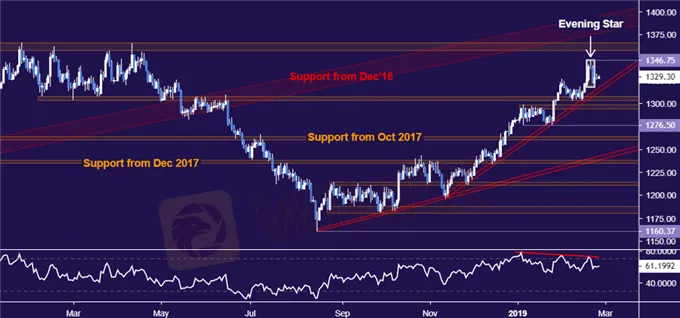简体中文
繁體中文
English
Pусский
日本語
ภาษาไทย
Tiếng Việt
Bahasa Indonesia
Español
हिन्दी
Filippiiniläinen
Français
Deutsch
Português
Türkçe
한국어
العربية
Crude Oil, Gold Prices May Fall on Fed Chair Powell Testimony
Abstract:Crude oil and gold prices may fall if Congressional testimony from Federal Reserve Chair Jerome Powell lifts the US Dollar.
Crude oil prices plunged after US President Donald Trump took twitter to talk OPEC out of raising prices further, saying they are “getting too high” and asking the cartel to “take it easy”. He ominously added: “[The] world cannot take a price hike – fragile!”
Besides stoking global slowdown fears, Mr Trump may be giving OPEC too much credit. As it happens, crude prices fell nearly 19 percent in the two weeks after it and other like-minded producers including Russia (the so-called “OPEC+” group) issued the latest coordinated production cut in early December 2018.
The subsequent rise has tracked the recovery in stocks, and so seems to owe to a broader recovery in risk appetite rather than OPECs influence. Still, the markets can hardly be expected to ignore an attempt to talk down prices by the leader of what is – as of 2018 – the largest oil-producing nation in the world.
Gold prices were little-changed, treading water, curiously unable to find meaningful support despite falling Treasury bond yields and a weaker US Dollar. Those moves might‘ve been expected to boost the relative appeal of anti-fiat and non-interest-bearing assets, but this clearly didn’t happen this time.
FED CHAIR POWELL TESTIMONY MAY HURT COMMODITY PRICE
From here, the spotlight turns Fed Chair Jerome Powell as he begins two days of semi-annual testimony in the US Congress. He is due at the Senate today and then sit for a repeat performance in the House of Representatives on Wednesday.
Last week, minutes from January‘s FOMC meeting offered a “wait-and-see” tone that clashed with the markets’ more overtly dovish disposition, lifting the US Dollar and hurting gold. Similar rhetoric from Mr Powell may produce analogous results.
In fact, the metals reticence to commit to a direction yesterday may well reflect worries about just such a possibility. Traders were perhaps unwilling to bet with gusto on the long side despite seemingly supportive market conditions, opting to wait for the Fed Chair to speak first.
Crude oil may also suffer if a stronger Powell lifts the Greenback, succumbing to de-facto selling pressure alongside other USD-denominated assets. Separately, API inventory flow data will be sized up relative to expectations calling for a 2.51-million-barrel build to be reported in official EIA figures Wednesday.
See our guide to learn about the long-term forces driving crude oil prices!
GOLD TECHNICAL ANALYSI
Gold prices continue to hover above support underpinning the uptrend from mid-November. A bearish Evening Star candlestick pattern coupled with negative RSI divergence continues to warn of topping. Confirmation of reversal on daily close below 1249.10 initially targets 1276.50. Alternatively, a push above the February 20 high at 1346.75 exposes the pivotal 1357.50-66.06 area.

CRUDE OIL TECHNICAL ANALYSI
Crude oil prices turned lower as expected, with sellers now probing support in the 55.37-75 area. This is reinforced by a rising trend line set from late December, now at 54.39. A daily close below the latter level would suggest the longer-term downtrend has resumed, initially exposing the 50.15-51.33 zone. Alternatively, a push above resistance in the 57.96-59.05 region aims for trend line support-turned-resistance set from February 2016, currently at 61.90.

Disclaimer:
The views in this article only represent the author's personal views, and do not constitute investment advice on this platform. This platform does not guarantee the accuracy, completeness and timeliness of the information in the article, and will not be liable for any loss caused by the use of or reliance on the information in the article.
Read more

KVB Today's Analysis: USD/JPY Eyes Volatility Ahead of BoJ Policy Meeting and US Data
The USD/JPY pair rises to 154.35 during the Asian session as the Yen strengthens against the Dollar for the fourth consecutive session, nearing a 12-week high. This is due to traders unwinding carry trades ahead of the Bank of Japan's expected rate hike and bond purchase tapering. Recent strong US PMI data supports the Federal Reserve's restrictive policy. Investors await US GDP and PCE inflation data, indicating potential volatility ahead of key central bank events.

Today's analysis: USDJPY Poised for Increase Amid Bank of Japan's Strategy
The USD/JPY is expected to rise. The Bank of Japan will keep interest rates between 0 and 0.1% and continue its bond purchase plan but may reduce purchases and raise rates in July based on economic data. Technically, the pair is trending upward with resistance at $158.25 and $158.44, and support at $157.00, $156.16, and $155.93.

Safe-haven yen, Swiss franc rise on Omicron fears, Fed policy uncertainty
The dollar ticked higher on Friday amid a broadly calmer tone in markets as fears over Omicron’s impact eased, but currency moves were muted ahead of a key U.S. payrolls report that could clear the path to earlier Federal Reserve interest rate hikes.

Safe-haven yen, Swiss franc rise on Omicron fears, Fed policy uncertainty
The dollar ticked higher on Friday amid a broadly calmer tone in markets as fears over Omicron’s impact eased, but currency moves were muted ahead of a key U.S. payrolls report that could clear the path to earlier Federal Reserve interest rate hikes.
WikiFX Broker
Latest News
Angel One is an Ideal choice for you ?
StoneX Group Strengthens Indian Presence with Bullion Exchange Membership & New Offices
6 Trading Platforms That May Put Your Money at Risk
Indonesian Woman Lured into S$1.3 Million Forex Scam by Friend
Be a part of SquaredFinancial Live Talk show on US Election
FCA fines personnel £350,000 for failing to notify the FCA of significant tax issues
Broker Review: Is Sure FX Reliable?
ATTENTION! WARNING AGAINST FRAUD BROKERS
FOREX.com Partners with Kalshi for Event-Based Trading on US Election
Alameda Sues KuCoin to Reclaim $50M in FTX Asset Recovery Drive
Currency Calculator


